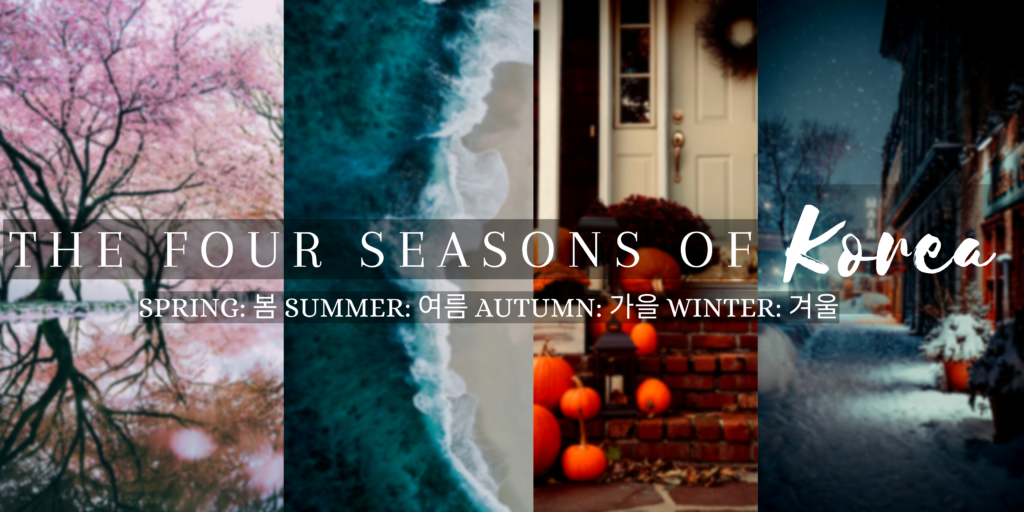
The Korean Seasons | A Different Perspective on the Four Seasons
Korean Seasons 계절 (Gyejeol)
From a picturesque view of the full bloom to a frozen paradise of the country that emerged from a catastrophe. Korean Seasons are one of the most beautiful assets of South Korea that offer a memorable trip.

Korean Seasons makes the country look like it is being bewitched in a romance. A romance that only destiny can take credit for. The country gets blessed with a set of quartets and confesses its deepest feelings when the world blooms to celebrate.
Spring 봄 (bom) is her chosen name as she danced down the altar looking like a bride all decked up with flowers. She greets the butterflies that accompany her and showers cherry blossoms on the visitors.
People wear hanbok and click random pretty pictures with theme-based candies and picnics loaded with delights of her wonder. Spring stays shortly from April to June decorating the whole country with her blooming hues.
Then comes the Summer 여름 (yeoreum) with the hot and humid temperature. It marks its days from July to August with a sun that shines brightly up above the head. Cicadas hum along with the cool breeze that blows occasionally bringing life to the exhausted.
The living seek solace in ice creams and beaches as the waves rush in to steal a touch of human beings. It washes away the feet and leaves them with pockets full of shelly gifts. The city is adorned with shades of green as it welcomes the three hottest days while embracing the 소나기 (sonagi).
Sambok (삼복) also known as dog days occurs between June and August with a 10-day interval in between each other.
The calendar notes Chobok 초복 as the beginning of the three hottest days of the summer raising the temperature from 31 to 37 degrees Celsius. People gather up for a bowl of samgyetang 삼계탕 ( Chicken ginseng soup ) to beat the heat.
The mid-dog day known as Jungbok (중복) follows right after Chobok, setting new records of the blistering heat. The city screams for an escape from the heavy rain (비; bi). Announcements about taking good care of your health along with tips to tackle the heatwave can be heard every now and then.
The scorching summer sets for its departure notifying the last dog day Malbok ( 말복 ) among the triplet. People get away to mountain streams and seashores to bid adieu to these last hottest summer days. Bokdarim (복달임) is the traditional word used for such outings and Samgyetang (chicken ginseng soup) still comes to the rescue to fight the fire with fire.
Autumn 가을 (gaeul) knocks at the doors with hellos from friendly ghosts and witches. Mythical creatures come alive and whisper tales in the alleyways. The mountains dress up in earthy tones as people engage themselves in Chuseok (추석), a three-day traditional autumn harvest festival. Shelves filled up with cards of Thanksgiving while exchanging pumpkin smiles and trick o’ treats.
December becomes a winter wonderland with a thick blanket of snow that covers up the land of the morning calm. People cover up in warm clothes while singing Christmas carols in the foggy mist. The country lights up to welcome the freezing cold while the world dozes off in a deep sleep of frosty dreams.
People find warmth in holding hands with their significant ones while sharing baked confections of love. Children await the surprises that the white-bearded grandpa brings in the dark night when the bells of the reindeer loudly ring.
Winter 겨울 (gyeoul) brings hope for a new beginning indulging Koreans in its chilly rides and homecoming. Ice skating, skiing, grabbing a hot meal with your family, or quickly running to the convenience store to find something warm to hold are the many activities that people occupy themselves with as the world longs for its hanami again to meet.

Also Read: Top 15 Amazing Facts About Korean Table Etiquettes That You Should Know Before Going To Korea





One Comment
Pingback: